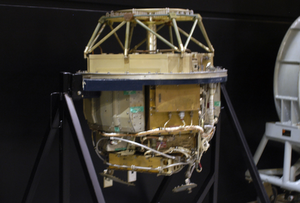| Emergency Rocket Communications System | |
|---|---|
 Emergency Rocket Communications System payload | |
| Type | Intercontinental ballistic missile/Communications System |
| Place of origin | United States |
| Service history | |
| In service |
|
| Used by | United States |
| Production history | |
| Manufacturer | Boeing |
| Unit cost | US$7,000,000 (equivalent to $61,332,057 in 2023) |
| Specifications | |
| Mass | 78,000 pounds (35,000 kg) |
| Length | 59 feet 9.5 inches (18.225 m) |
| Diameter | 5 feet 6 inches (1.68 m) (1st stage) |
| Warhead | 1 kW UHF Transmitter |
| Engine |
|
Operational range | 8,100 miles (13,000 km) |
| Flight altitude | 700 miles (1,100 km) |
| Maximum speed | Approximately 15,000 miles per hour (Mach 20; 24,000 km/h; 6.7 km/s) (terminal phase) |
Guidance system | Inertial |
Launch platform | Silo |
The Emergency Rocket Communications System (ERCS) was designed to provide a reliable and survivable emergency communications method for the United States National Command Authority, using a UHF repeater placed atop a Blue Scout rocket or Minuteman II intercontinental ballistic missile.[1]: 34-37 ERCS was deactivated as a communication means when President George H.W. Bush issued a message to stand down SIOP-committed bombers and Minuteman IIs on 27 September 1991. Headquarters SAC was given approval by the Joint Chiefs of Staff to deactivate the 494L payloads beginning 1 October 1992.[2] However, Headquarters SAC believed it was inefficient and unnecessary to support ERCS past fiscal year 1991, and kept the accelerated deactivation schedule.
- ^ Heacock, Phillip K. (January–February 1979). "The Viability of Centralized Command and Control (C2)". Air University Review. 30 (2): 34–37. eISSN 1554-2505. ISSN 1555-385X. LCCN 2002207178. OCLC 50625917. Retrieved 14 July 2022 – via Internet Archive.
- ^ "RE: Emergency Rocket Communications System Deactivation". Strategic Air Command History, 1 Jan – 31 December 1991. 30 April 1991. Retrieved 8 December 2012 – via Scribd.